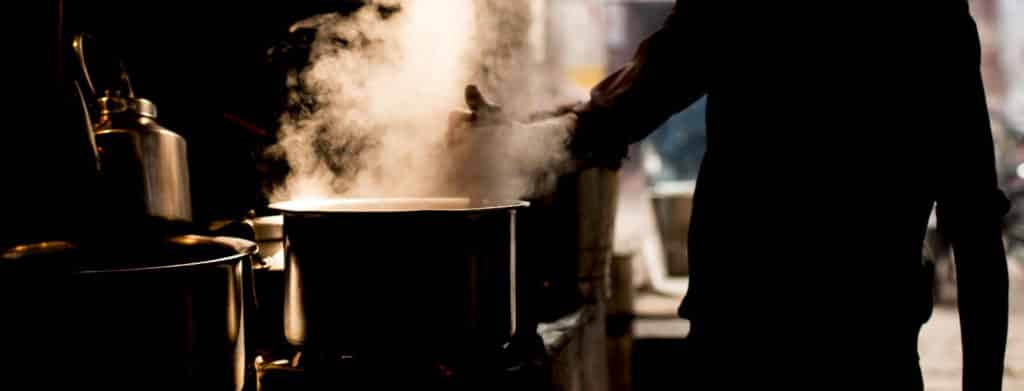Masala chai, or "spiced tea", is renowned for its abundance of comforting spices. There are many variations of chai spices, depending on region, family tradition and individual preference. Here's a guide to the Masala chai spices used in India and elsewhere.
Masala chai's main organic spices
These spices are present in almost all versions of Masala chai:
Cinnamon is rich, very slightly pungent and tannic - a great base for most Masala chai. Whole cinnamon sticks are more common than powders. In the USA, cassia (unfortunately often sold as cinnamon) replaces true cinnamon, which is paler, more delicate and made up of many thin layers of bark (rather than thick sheets of bark).
Some consider that the cardamom pods, which are highly aromatic, cool down the chai. I find, on the contrary, that cardamom balances the spice blend well with its distinctive flavor and fragrance. Lightly crushed and roasted green cardamom pods just before boiling will give Masala chai an even greater flavor. Today, green cardamom has become unaffordable, with India and Guatemala sharing the cultivation. In some recipes, cardamom may be called "elaichi" or "elchi", its southern Indian name.
Cloves give Masala chai incredible depth and act as a perfect smoothing agent for its creaminess and sweetness. Although whole cloves offer a better flavor, powdered cloves also work wonderfully, revealing notes of chocolate.
Hot, sweet ginger is a great spice to add to the mix. Ideally, you should use fresh ginger (but be careful with the dosage), the best compromise being to have it in the form of fragments or small rhizomes; in the worst case, a good powder will do (not the kind you find in Asian supermarkets, or for that matter anything else).
Pepper is the spice least used in Masala chai, but many say that chai is not chai without pepper. Cracked black peppercorns are often used. However, whole black peppercorns are preferable as they retain their flavor better. For a milder pepper taste, whole white or green peppercorns can be used.
Regional Masala Chai spices
Ajowan (Trachyspermum ammi)
This bitter digestive seed from India tastes like thyme, caraway or cumin, and is rarely used in chai outside certain regions of India.
A freshly ground four-spice blend gives Masala chai extra complexity and depth.
Coriander comes from the coriander fruit, but is commonly referred to as the "seed" of the plant. In the world of beverages, it is recognized as a main component in the flavors of many Belgian beers, but as an optional spice in Masala chai. It gives chai a slightly lemony flavor, while remaining in line with the general theme of spicy sweetness.
They're not just for bouquet garni! In some regions of India, they are an essential spice for Chai. Fresh leaves have a mild flavor, while dried leaves have a more intense taste. Indian bay leaves have a flavor closer to cassia (the spice generally sold as cinnamon in the U.S.), making them an ideal candidate for chai. Be careful, however, not to use the fresh leaves of our European bay trees: they are toxic.
Chocolate
Chocolate is a typically Western contribution to chai. It can be added in the form of chocolate pieces, cocoa powder or even chocolate syrup. Many cafés offer chocolate tea with chai, and some also offer vanilla tea, hazelnut tea, coffee with tea and much more, so there's no end to the nonsense?
The aromatic flavor of fennel, similar to that of aniseed, adds sophistication and charm to masala chai. The dried, light-green seeds should be roasted before use and added at the last minute to the boiling spice mixture (to prevent it from overpowering the infusion). In some masala chai recipes, it is called by its Hindi name, "sonf" or "soanph".
Licorice should be used with great care in a spice blend, because while it adds roundness, it can also take over very quickly! So dose with caution, but once you've got the dosage right, it's a wonderful ingredient that will unite your blend.
Mace is the protective shell of the nutmeg seed. It has a similar flavor, but is much more delicate. Like licorice, it's essential to know how to dose it: too much mace and your blend becomes undrinkable.
Its price tag may dampen the spirits of some, but a few filaments are all it takes to change the configuration of your Masala Chaï, and not just a little! Three or four pistils per cup and you're done. And don't forget that saffron and tea are a great combination!
Star anise is very strong, but like green anise, it lends a fresh, rounded note to the spice blend. Use with care.
Tamarind
Fresh or powdered tamarind adds a tangy, fruity note to the mix, or try replacing it withhibiscus, which is perfect as an acidulant.
Like chocolate, vanilla is a Western addition to chai tea. I'm not a big fan of this addition, but why not after all? Just know how to dose it.
White poppy seeds(Papaver somniferum var. album)
In some parts of India, roasted white poppy seeds (also known as "khaskhas") are used in Masala chai.
If you've come across any variations on the tea spice blend, please let us know.

